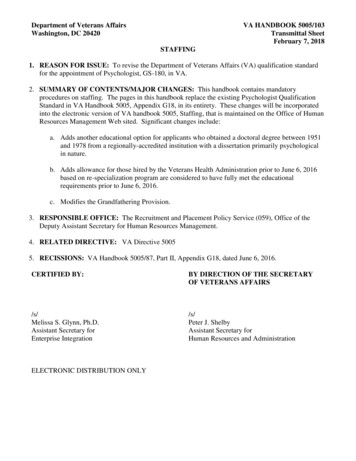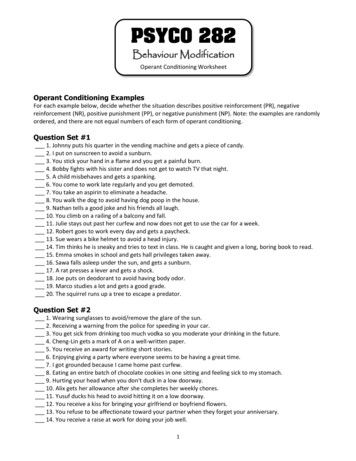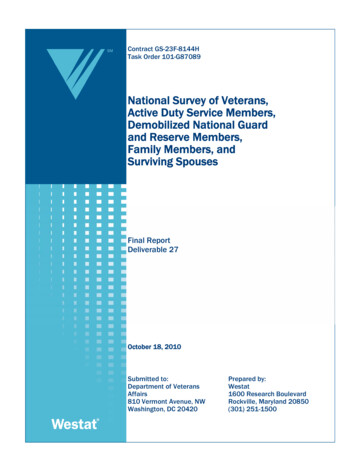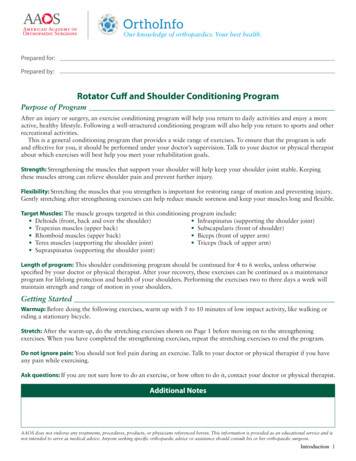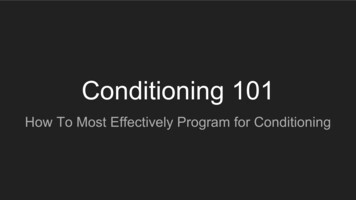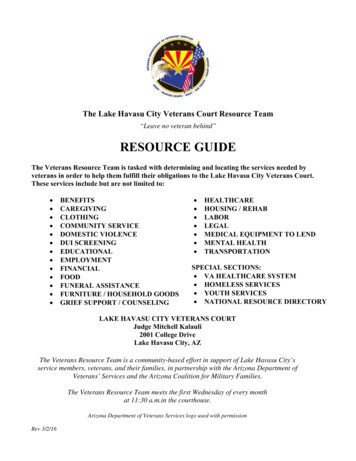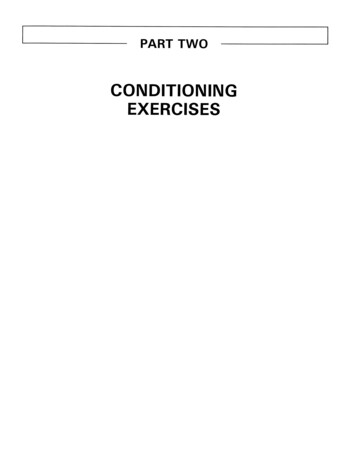
Transcription
PART TWOCONDITIONINGEXERCISES
NEWSDAY/J . CONRAD WILLIAMS, JR .
INTRODUCTIONThe physical conditioning routines included inthis book offer possibilities for individuals withlower limb amputation . We begin with calisthenicsand stretches to improve flexibility and range ofmotion, followed by exercises to develop strengthand muscular endurance in specific muscle groupsfor the arms, shoulders, legs, abdomen, chest, andback.The conditioning exercises are performed withequipment such as Nautilus, available in most healthclubs . An individual with a lower limb amputationcan usually work the same muscle groups on thesame equipment as can a nondisabled person, butnot always in the same manner.Special adaptations or modifications that willhelp to make these exercises safe and effective arenoted in the corresponding descriptions . In manycases, the prosthesis alone provides the necessarysupport for the movements required . Exercises thatwill help strengthen the muscles of the residual limbare also indicated in the descriptions . Many of theexercises in Part Two are performed while theparticipant is seated ; this allows the participant toconcentrate on the exercises and weights withouthaving to worry about maintaining balance whilestanding.Variations for some of the exercises depend onthe level of amputation . Range of motion andbalance may not be the same for a person with anAK amputation as they are for someone with a BKamputation . Besides level of amputation, othervariables include the surgical history, previous train-ing, and type of prosthesis used . The prosthetist,therapist, and exercise instructor can help identifythe best opportunities for exercise based on thesevariables.The exercises illustrated in this book are performed by athletes who train on a regular basis . Allare in excellent physical condition and demonstrateexercises that require a range of skill and practice.Beginners should not attempt to perform any of theexercises without first consulting a physician.CAUTIONPeople with back injury should avoid liftingheavy weights in their exercise programs . To developstrength and endurance, they should do morerepetitions with light weights rather than increasingthe resistance.Any exercise has the potential to cause injury tothe back, whether or not one has had previous backinjury . In particular, this would include sit-ups andother exercises involving hyperextension of the back,as noted in Chapter 10, Abdominals, Leg exercisesrequiring special caution, as noted in their descriptions, are squats and dead lift . Exercises that makethe lower back vulnerable to injury are noted inChapter 12, Back Exercises.It is important that persons entering an aerobicexercise program obtain medical clearance prior tooutlining the exercise regime . This precaution isrepeatedly stressed throughout this text . Individuals23
24RRDS Clinical Guide . Physical Fitness : A Guide for Individuals with Lower Limb Losswho have hypertension, for example, are particularly at risk in weight training as well as aerobicprograms . Coronary artery insufficiency is anotherexample of a risk factor in undertaking an aerobicexercise program . These risks apply for thenonamputee as well as the amputee . Medical clearance at all ages is absolutely necessary.MONITORING THE INTENSITY OF AEROBICEXERCISEIn order for exercise to promote optimumaerobic benefit, it must cause the heart to work atan accelerated rate and in a steady state for a periodof time . Monitoring the heart rate during exercise isthe best way to determine whether the routine isproviding the desired aerobic benefits while ensuringthat the heart is not being overworked . It is done byestablishing a target heart rate and monitoring thebeats per minute immediately after the conditioningexercise routine is completed . The goal is to maintain the target heart rate throughout the exerciseperiod (warm-up and cool-down are not part of thisperiod) .Establishing a Target Heart Rate RangeA target heart rate range for exercise can bepredicted as follows : 1) a person's age in years issubtracted from 220 to give the maximum predictedheart rate (beats per minute) ; 2) the range isdetermined by figuring the percentage of the maximum rate that the person must work during exercisein order to achieve his/her target goal (70 to 85percent is the range which is considered to be themost effective for receiving adequate aerobic benefits) . For example, a 35-year-old person will have amaximum predicted heart rate of 185 (220 minus35) . If this person begins an exercise regimen with agoal of maintaining a 78 percent target heart rate,his/her target will be 144 heartbeats per minute(0.78 times 185).Exercise at the targeted rate should last from 15to 30 minutes . During this time the heart rate ismonitored . Immediately after the routine is completed, the pulse should be taken to determine theheart rate. Most people take a 10-second, ratherthan a full minute, pulse count . The 10-secondcount is then multiplied by 6 . Any irregularity inheart rate, including rapid variations, calls forSAMPLE CIRCUIT TRAININGSIT UPSBENCH PRESSLATERAL PULL DOWNLEG PRESSSIT UPSMILITARY PRESSPULL UPSINCLINE PRESS
25Conditioning Exercises : Introductiondiscontinuing the exercise immediately and consulting a physician.A Target Heart Rate Range for Moderate ExerciseCertain individuals may not be able to exerciseas strenuously as others . A 60 to 65 percent ofmaximum heart rate is a safe and still effectivetarget range, especially for an older person . An evenlower rate may be necessary for some individuals;therefore, when the intensity is lower, the exerciseperiod should be extended from 30 to 50 minutes.Indications of overuse include fatigue, poorsleeping patterns, and discomfort for extendedperiods of time following exercise . If it is difficult toreach a heart rate of at least 60 percent ofmaximum, a lower rate will give adequate aerobicbenefits if the number of repetitions of each exerciseis increased.RELATIONSHIP OF MUSCULAR CONDITIONINGTO HEALTHMuscular conditioning is vital to overall fitness.Most body movements rely on the relationshipbetween the muscular and skeletal systems . Weighttraining can reduce the resting heart rate and iseffective for relieving stress . With the proper diet,body fat can also be reduced while muscle mass isbeing increased.Exercising properly with weights is the mosteffective way to build strength and muscular endurance . Heavy weight resistance with a low number ofrepetitions builds strength, while light weight resistance with a high number of repetitions buildsendurance.Cardiovascular BenefitsWeight training is essentially anaerobic exercise.While it does not develop the cardiovascular systemas well as running, swimming, or bicycling, weightresistant exercise will develop strength and endurance in the muscles of the legs and upper body sothat those muscles do not tire before the cardiovascular system can be improved.If the intensity level of weight training is kepthigh, it can have a positive effect on the cardiovascular system . To do this, the exercises must beperformed in such a manner as to maintain between60-90 percent of maximum heart rate . One way toachieve this is to do each set of exercises in a con-tinuous circuit, eliminating rest periods betweeneach set . A high number of repetitions and lightweights are usually recommended for this type oftraining.A sample of circuit training follows:The pulse should be checked periodically whileexercising to confirm that it is in the target zone . Intime, the exerciser will be able to tell by his or herbreathing rate whether he/she is in the target zoneand will only need to monitor pulse rate after completing the circuit . The weights used can be adjustedto help control the heart rate, but heavy weightsshould not be used for aerobic conditioning . Running or jumping rope for 30 seconds between sets isanother option for maintaining circuit training.Muscular BenefitsWhether or not one participates in sports andrecreational activities, muscular conditioning is important for good physical fitness . Toning, strengthening, flexing, and stretching muscles through aregular program of progressive weight resistanceexercises will aid in developing good posture, helpprevent injury, increase endurance for daily tasks,create higher energy levels, improve circulation, andadd to a person's total self-image . Muscular conditioning is also basic for successful participation insports that require strength and endurance, andshould always supplement aerobic training programs.Conditioning through weights results in increased muscular strength and size (hypertrophy)that cannot be attained in any other way . Circulation through the muscles increases, and the numberand density of capillaries within muscle fiber mayalso increase . Muscle enzyme levels rise along withblood volume and hemoglobin . Weight trainingstrengthens bones, as well as ligaments and tendonsthat connect muscles to bones . Some physiologistscontend that weight training aids in digestion andcan improve elimination.Applications to Physical RehabilitationProgressive resistive exercise (PRE) as a physical rehabilitation technique was the result of medicalexperiments performed by an orthopedist, ThomasL . DeLorme, MD, following World War II .* Mus* T .L . DeLorme, "Restoration of Muscle Power by Heavy ResistanceExercises, " Journal of Bone and Joint Surgery, 4-B, 1945, pp . 645-667 .
26RRDS Clinical Guide . Physical Fitness : A Guide for Individuals with Lower Limb LossGUIDELINES FOR TRAINING WITH WEIGHTSGENERALDO'SANDDON'TSStart with light weights and lift weights progressively . Never start with theheaviest set first : the muscles and tendons are not prepared for suddenexertion.Do not continue lifting the weights to your maximum ability on the first set ofrepetitions.Increase the size of the weights by 5 to 10 pounds after you are able toperform 10 repetitions per set with ease.Always work the larger muscles of the body first . Small muscles are neededfor lifting heavier weights but they become fatigued more quickly than largermuscles . For example, the smaller muscles of the arms often becomefatigued before the large muscle groups of the chest or back can beeffectively worked.Learn and always use the correct form for lifting the weights.FREQUENCYANDDURATIONFrequency and duration depend on personal goals . Maintain a minimumcommitment of time in order to keep the body in good physical condition.An exercise workout 3 times a week is usually needed to gain significantresults . Workout sessions should last from 30 to 90 minutes with a rest dayin between, which allows the exercised muscles to recover and growstronger.A schedule should be established and maintained . Nothing should interferewith your workout time . If you do miss a workout session, get back onschedule as soon as possible.A competitive body builder or power lifter may train as many as 5 or 6 timesa week . Even in this type of routine, each muscle group is usually given a dayof rest between ginners are encouraged to have a spotterpresent when usingfree weights . Certainexercises will require aspotter regardless ofskill level (e .g ., squats) .The following are Nautilus recommended guidelines for increasing the numberof repetitions when training with weights . (These guidelines will be repeatedin the introduction of each chapter presenting weight-training exercises .)Always do warm-up exercises before lifting weights.Start with a minimum of 8 repetitions with a given weight . If a minimum of 8repetitions cannot be completed, the weight is too heavy for you and theresistance should be lowered until 8 repetitions can be completed.When 12 repetitions can be successfully completed, the weight should beincreased by 5-10 pounds . When 12 repetitions can be completed with theincrease in pounds, the weight may be increased again.Work up to 1 5-20 repetitions per set for muscle maintenance, endurance,and tone.When performing exercises with free weights, it is recommended that 2-6sets for each particular muscle group be used .
27Conditioning Exercises : IntroductionGUIDELINES FOR TRAINING WITH WEIGHTSLEVEL OFDIFFICULTYAND INTENSITYA general level of difficulty is rated for each of the conditioning exercises inthis book . You can vary the level of intensity by adjusting the amount ofweight.Do not lift to your maximum ability on the first few sets of repetitions . In thisway you will not experience excess fatigue, which could keep you fromfinishing the workout.Work at your own pace . Do not compare your own progress with the abilitiesof others . Always maintain proper form.As you irnprnve, you may add more exercises, increase the number of sets,add more weight, and shorten rest periods.BREATHINGDo not hold your breath while lifting . This could stop the flow of oxygen tothe brain, which might result in fainting . Holding your breath while lifting canalso close off the escape of air through the glottis, causing a suddenincrease in thoracic pressure . For this reason, many physicians do notrecommend weight training for postcoronary patients.Breathe in a rhythmic pattern . Some people find it best to exhale while liftinga weight or moving against resistance and inhale as the weight is lowered orresistance removed . Others find it better to reverse the breathing for certainkinds of exercises, such as those involving movements above the head or inchest expansion workouts.PROGRESSKeep a record of the number of sets and repetitions for each exercise in yourworkout in order to monitor your progress and increase the resistance of theweights in a regulated fashion.If your goal is to gain or lose weight, gain muscle mass or lose bulk, you maywish to keep a record of your body weight and measurements on a regularbasis for future comparison and a record of progress . Photos with front,baok, and side views are also ho!pful.
28RRDS Clinical Guide . Physical Fitness : A Guide for Individuals with Lower Limb Losscular conditioning through PRE is now used in preand postoperative care, chronic orthopedic conditions, asthmatic and cardiac conditions, posturalproblems, postpolio care, neurological conditions,motor coordination, and other postinjury therapy.Training with weights not only helps one lookand feel better, it can also improve self-image . Forthe disabled individual, increasing muscle size,strength, and endurance can help to restore selfconfidence . Feeling strong results in feeling well andhealthy . Muscular conditioning can help people withdisabilities feel more positive about their bodies byemphasizing areas of the body which still have function and by working to rehabilitate weakened areas.The results of regular muscular conditioningwill be beneficial to the young or old, disabled ornondisabled . Whatever the goal, there is a programthat can be tailored to the current physical conditionof anyone in reasonably good health . A physicianshould be consulted before any type of program ofmuscular conditioning is undertaken.Principles of TrainingPhysical fitness programs for rehabilitation,strength conditioning, body building, and toninghave different routines . Guidelines are needed tosafely and effectively begin any of these programs.In time, individuals usually discover what kind ofroutine and which exercises are best for their particular needs . An experienced trainer and a rehabilitation team should work with the person with lowerlimb amputation in designing such a program.A basic training principle is that each musclegroup should be worked every other day, not onconsecutive days ; thereby giving the muscles achance to recover from the stresses of exercise.Exceptions to this are the calf and abdomen muscles, which may be exercised every day because theyare used in daily activities.A program should start with a light routineperformed three times a week with a day of restbetween each session . The program will usuallyconsist of three sets of exercise for muscle groups ofeach part of the body, with 10 repetitions per set.Each body segment should be worked using one ortwo different exercises . In the beginning, thereshould be a 60-second rest period in order to let themuscles recover . Once a routine is established andsuccessfully performed, one can increase the intensity of the workout by gradually reducing the resttime to 30 seconds . For very heavy weight sets,longer rest periods are acceptable.In the first week, only one set per muscle groupshould be performed in order that the movements ofeach exercise may be learned and the musclesallowed to adjust to the new stresses . Two sets maybe performed during the second week and three setsduring the third week . This routine should becontinued for a total of 8 weeks . When the eighthweek is completed, the program should be evaluated . If this routine is suitable, the exerciser maycontinue increasing the number of sets and weightseach week . Intermediate and advanced conditioningprograms require increasing weight repetitions andsets, as well as adding new exercises.WARM-UP AND COOL-DOWN EXERCISEFlexibility and range of motion are developedand maintained by calisthenics and stretching exercises before and after the strengthening routine.A good warm-up prepares the muscles, ligaments, and tendons for action . It steps up bloodcirculation, raises the body temperature, and enhances flexibility of the joints. By limbering themuscles and joints, these exercises can prevent manyinjuries . Warming up before strenuous or activeexercise is especially important in cold weather.The warm-up should consist of some calisthenics, stretching exercises, and light resistance exercises . It should take from 10 to 20 minutes . Each bodypart should be moved through a full range of motion, first without resistance, then with light resistance. (Most experienced weightlifters use a light firstset of their resistant exercises as a part of their warmup .) Bicycling and running in place are also goodforms of warming up for weight-resistant exercises.Cooling down after completing the entire exercise routine is very important . It helps the bodymake the transition from high-intensity activity to anormal level. Stretching and low-grade calisthenicsare best for the cool-down . Cool-down stretches canhelp prevent muscle soreness . A light jog or bikeride is also a useful means of cooling down . At least10 to 20 minutes should be allowed for cool-downexercises.Many weightlifters cool down individual bodyparts as they complete sets of exercises by doing 8 to10 repetitions using a lighter weight than that usedin the routine .
29Conditioning Exercises : IntroductionBASIC BEGINNING WORKOUT PROGRAMWarm-up Exercises ; repeat for Cool-down ExercisesChapterPageJumping Jacks540Neck Rolls541Trunk Twists545Supine Leg Raise10120Push-ups11144-148Overhead Bent-Arm Stretch653Shoulder/Arm Stretch654Quadriceps Stretch663-64Hamstring Stretch6653-5 minutes : calisthenics3-5 minutes : stretches* Include any additional calisthenics or stretches you feel are appropriate.* 3-5 minutes of stationary bicycling (see Chapter 18) or jogging (see Chapter 15)also may be used for warm-up and cool-down exercises.BASIC BEGINNING WORKOUT PROGRAMResistance ExercisesRepetitionsSetsTitleChapterPage8-12 or 15-203Nautilus Abdominal Chair101298-12 or 15-202-3Single Knee Extension9938-1 2 or 15-202-3Leg Curl91098-12 or 15-202-3Push-ups11144-1488'12 or 15'202-3Nautilus Bench Press111528-12 or 15-203Overhead Press882O-12 or 15-203Nautilus Lat . Pull-down121698-12 or 15-203Triceps Curl771, 748-1 2 or 15-203Seated Arm Curl776
30RRDS Clinical Guide . Physic& Fitness : A Guide for Individuals with Lower Limb LossPROFILES OF THE EXERCISERSSamantha EllisSamantha Ellis is an exceptional person . She ismissing both limbs above the knee, but the ability tobear weight on the end of one of her residual limbshas given her an advantage in being able to developher remarkable skills in physical activities.The prostheses Ms . Ellis uses for most activitiesare Endolites with Contoured Adducted Trochanteric/Contained Alignment Method (CAT/CAM)Flexible Sockets made with a polyethylene innersocket and polypropylene outer frame socket . Shealso uses a Mauch Swing Phase Hydraulik TM KneeUnit for increased knee stability, along with theEndolite Stabilized StanceFlex Knee.Ms . Ellis swims to stay in good physicalcondition and also plays golf . She discovered thebenefits of health club equipment for strengthconditioning and has taken up downhill skiing forrecreation . Born and raised in England, Ms . Ellisnow works part of the year in the United States ata.f.i . Endolite in Hialeah, Florida as a customerrelations representative .
31Conditioning Exercises : introductionJohn EverettJohn Everett is a Vietnam veteran who hasbilateral below-knee amputations . He works outregularly with the same prostheses that he uses forhis daily activities . He rides a stationary bicycle andwalks for aerobic exercise . In the winter months, heenjoys downhill skiing . He feels that exercise enableshim to be an active participant in recreationalsports, as well as helping him to have more energy inhis everyday routine.His prostheses are exoskeletal in design withSeattle Feet, pelite liners, silicone end pads, NewSkin cosmetic finishing, USMC's Adjustable LeakRate Small Suction Socket Valves, and theActivSleeve Suspension System. Although theActivSleeve System produces a suction-type suspension, the addition of the small suction valve helps topurge any extra air from the socket (a 3-ply socketfit with a DAW Sheath underneath), which ensurestrue atmospheric suspension . When working out inthe gym, Mr . Everett sometimes adds an extra plysock and interchanges his pelite liner with the PMliner, which helps absorb the extra forces placed onhis residual limbs.Mr . Everett counsels people with drug addictions, does peer counseling in amputee supportgroups at Harborview Hospital and other locationsin the Seattle area, and is a volunteer at theProsthetics Research Study, a firm in Seattle .
32RRDS Clinical Guide . Physical Fitness : A Guide for Individuals with Lower Limb LossRichard HughesRichard Hughes has a below-knee amputation.He enjoys a variety of sports and stays in goodphysical condition by sculling in his own boat . Hecompetes in triathalons, which requires him tomaintain several types of prostheses for severalsports activities . Mr . Hughes is chief of the Technical Marketing Department for a .f.i . Endolite inHialeah, Florida. He has also worked as a clinicalprosthetist.The artificial limb Mr . Hughes uses mostfrequently consists of a skin-fit suction below-kneeprosthesis with a flexible wall polyethylene innersocket and a polypropylene outer frame socket,which is cut out over relief areas for increasedcomfort and lighter weight . An Endolite prosthesisis also incorporated into the design with an adaptedSeattle Foot and the ActivSleeve Suspension System .
33Conditioning Exercises : IntroductionGreg ManninoIf Greg Mannino looks familiar to you it isbecause he is a highly visible professional amputeeathlete . He trains year-round to maintain his ranking as one of the top downhill three-track skiers inthe world . When he is not race training in Vail,Colorado, or traveling to a ski race, he is workingon staying in good physical condition by liftingweights regularly . He also enjoys bicycling, running,cross-country skiing, and horseback riding.Mr . Mannino, who has an above-knee amputation, wears an Endolite prosthesis with the Stabilized StanceFlex (Bouncy) Knee, with the MauchSwing Phase Hydraulik Knee Unit . He feels that thecomfort of his CAT/CAM flexible walled socket hascontributed to his ability to achieve a high level ofperformance.
34RRDS Clinical Guide. Physical Fitness: A Guide for Individuals with Lower Limb LossMike NitzMike Nitz was a competitive power lifter beforelosing his leg above the knee . He has since returnedto the gym and has designed a program thataccommodates for his limb loss and prosthesis andstill allows him to maintain a high level of intensityduring workouts . The only exercises he has notcontinued are standing squats and the dead lift.Mr. Nitz was back at work soon after receivinghis first prosthesis . Because his job as a sanitationengineer is physically demanding, he feels it is notonly important for him to stay in good physicalcondition but also to have a prosthesis that canperform adequately . He uses a Narrow ML FlexibleBrim Socket with a Mauch Swing and Stance PhaseKnee Control Unit (Mauch SNS Knee Unit) and theFlex-Foot .
35Conditioning Exercises : IntroductionLinda PedersenLinda Pedersen works out on Nautilus equipment at least three times a week . She enjoys snowskiing in the winter and has competed in regional skiraces sponsored by the National HandicappedSports and Recreation Association (NHSRA) . Sheplays tennis, water skis, and has played severalseasons of crutch soccer as co-captain of a Seattle,Washington team . A former track star in highschool prior to losing her leg above the knee, Ms.Pedersen is an excellent foot-over-foot runner.She uses an everyday walking prosthesis formost of her activities . It consists of a quadrilateralsuction socket, Mauch SNS Knee Unit, and OttoBock SACH Foot . This exoskeletal prosthesis issimple in design and requires very little maintenance . For running, she often wears the Terry FoxSpring Shank and the Seattle Foot.Ms . Pedersen is an administrative assistant inthe Property Department of the Johnson andHiggins Insurance Brokerage firm in Seattle anddoes volunteer work at the Seattle Prosthetic Research Study .
36RRDS Clinical Guide . Physical Fitness : A Guide for Individuals with Lower Limb LossAlbert RappoportAlbert Rappoport, one of the authors of thisbook, had been athletic prior to losing his leg belowthe knee and has worked to regain his abilities . Heenjoys weight training, swimming, and skiing forfitness and plays tennis and racquetball.Mr . Rappoport wears primarily one prosthesisfor his everyday activities, as well as for theweightlifting exercises shown in this book . Thebelow-knee exoskeletal prosthesis uses a petite liner,silicone end pad, wool sock and sheath, ActivSleeveSuspension System, and Seattle Light Foot . Mr.Rappoport also wears a Flex-Foot prosthesis fabricated with a graphite epoxy socket for activities thatinvolve running . The socket is a duplicate of thatused with his regular prosthesis and utilizes the sameliner . Stationary rowing photos show him using anendoskeletal prosthesis with Otto Bock components,ActivAnkle, and the Carbon Copy II Symes Foot.Mr . Rappoport is a prosthetist in privatepractice and director of the Performance ProstheticOrthotic Center, Santa Monica, California . Previously, he was chief research prosthetist at theProsthetics Research Study, Seattle, Washington.He also has worked as a Nautilus instructor and hastaught courses in physical conditioning at the University of Southern California .
Physical Fitness: A Guide for Individuals with Lower Limb Loss GUIDELINES FOR TRAINING WITH WEIGHTS GENERAL DO'S AND DON'TS FREQUENCY AND DURATION INCREASING THE NUMBER OF REPETITIONS CAUTION Beginners are encour-aged to have a spotter present when using free weights. Certa
